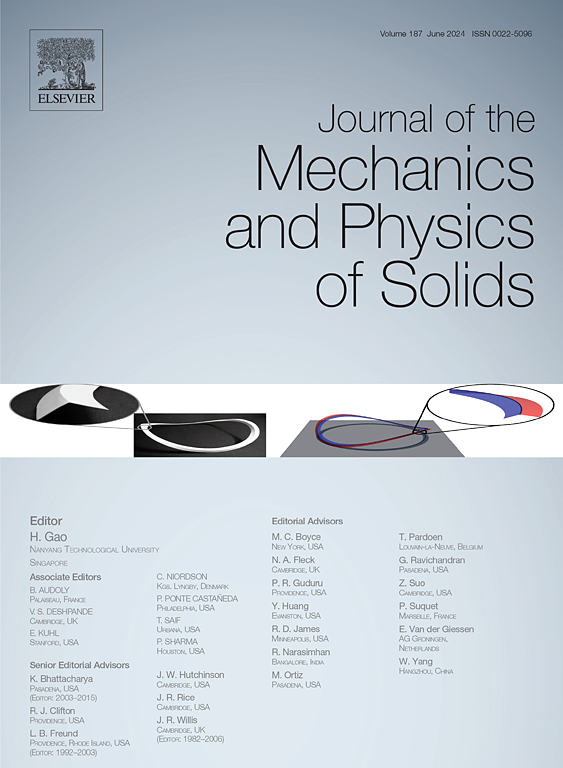Modeling and computation of the effective elastic behavior of parallelogram origami metamaterials
IF 6
2区 工程技术
Q2 MATERIALS SCIENCE, MULTIDISCIPLINARY
引用次数: 0
Abstract
Origami metamaterials made of repeating unit cells of parallelogram panels joined at folds dramatically change their shape through a collective motion of their cells. Here we develop an effective elastic model and numerical method to study the large deformation response of these metamaterials under a broad class of loads. The model builds on an effective plate theory derived in our prior work (Xu et al., 2024). The theory captures the overall shape change of all slightly stressed parallelogram origami deformations through nonlinear geometric compatibility constraints that couple the origami’s (cell averaged) effective deformation to an auxiliary angle field quantifying its cell-by-cell actuation. It also assigns to each such origami deformation a plate energy associated to these effective fields. Seeking a constitutive model that is faithful to the theory but also practical to simulate, we relax the geometric constraints via corresponding elastic energy penalties; we also simplify the plate energy density to embrace its essential character as a regularization to the geometric penalties. The resulting model for parallelogram origami is a generalized elastic continuum that is nonlinear in the effective deformation gradient and angle field and regularized by high-order gradients thereof. We provide a finite element formulation of this model using the interior penalty method to handle second gradients of deformation, and implement it using the open source computing platform Firedrake. We end by using the model and numerical method to study two canonical parallelogram origami patterns, in Miura and Eggbox origami, under a variety of loading conditions.
平行四边形折纸超材料有效弹性行为的建模与计算
折纸超材料由平行四边形面板的重复单元格在折叠处连接而成,通过单元格的集体运动极大地改变了它们的形状。本文建立了一种有效的弹性模型和数值方法来研究这些超材料在大载荷作用下的大变形响应。该模型建立在我们先前工作中推导的有效板块理论的基础上(Xu et al., 2024)。该理论通过非线性几何兼容性约束,将折纸的(细胞平均)有效变形与辅助角度场耦合,量化其细胞对细胞的驱动,捕捉所有微应力平行四边形折纸变形的整体形状变化。它还为每一个这样的折纸变形分配一个与这些有效场相关的板能量。我们通过相应的弹性能量惩罚放宽几何约束,寻求一种既忠实于理论又能实际模拟的本构模型;我们还简化了板能量密度,以包含其作为几何惩罚的正则化的本质特征。所得的平行四边形折纸模型是一个广义弹性连续体,其有效变形梯度和角度场是非线性的,并被它们的高阶梯度正则化。采用C0内罚法对该模型进行二次梯度变形处理,给出了该模型的有限元表达式,并在开源计算平台Firedrake上实现。最后,利用该模型和数值方法研究了Miura折纸和Eggbox折纸两种典型的平行四边形折纸图案在不同载荷条件下的表现。
本文章由计算机程序翻译,如有差异,请以英文原文为准。
求助全文
约1分钟内获得全文
求助全文
来源期刊
CiteScore
9.80
自引率
9.40%
发文量
276
审稿时长
52 days
期刊介绍:
The aim of Journal of The Mechanics and Physics of Solids is to publish research of the highest quality and of lasting significance on the mechanics of solids. The scope is broad, from fundamental concepts in mechanics to the analysis of novel phenomena and applications. Solids are interpreted broadly to include both hard and soft materials as well as natural and synthetic structures. The approach can be theoretical, experimental or computational.This research activity sits within engineering science and the allied areas of applied mathematics, materials science, bio-mechanics, applied physics, and geophysics.
The Journal was founded in 1952 by Rodney Hill, who was its Editor-in-Chief until 1968. The topics of interest to the Journal evolve with developments in the subject but its basic ethos remains the same: to publish research of the highest quality relating to the mechanics of solids. Thus, emphasis is placed on the development of fundamental concepts of mechanics and novel applications of these concepts based on theoretical, experimental or computational approaches, drawing upon the various branches of engineering science and the allied areas within applied mathematics, materials science, structural engineering, applied physics, and geophysics.
The main purpose of the Journal is to foster scientific understanding of the processes of deformation and mechanical failure of all solid materials, both technological and natural, and the connections between these processes and their underlying physical mechanisms. In this sense, the content of the Journal should reflect the current state of the discipline in analysis, experimental observation, and numerical simulation. In the interest of achieving this goal, authors are encouraged to consider the significance of their contributions for the field of mechanics and the implications of their results, in addition to describing the details of their work.

 求助内容:
求助内容: 应助结果提醒方式:
应助结果提醒方式:


